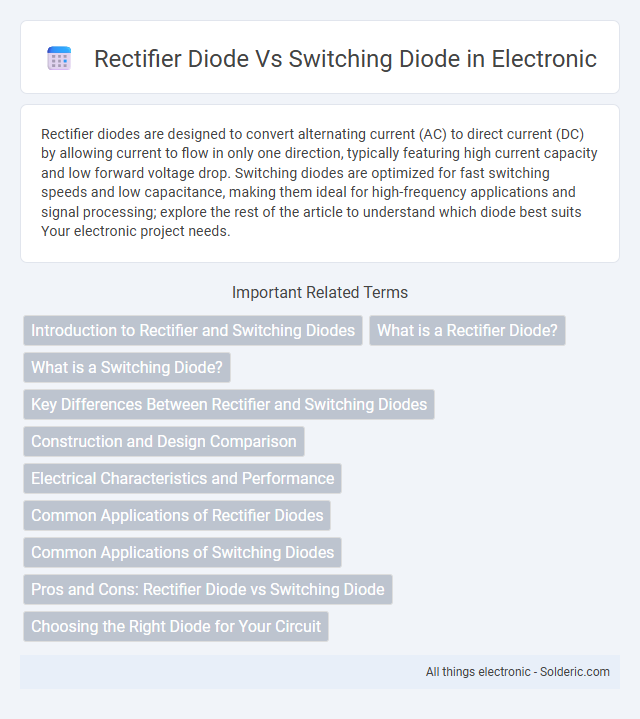Rectifier diodes are designed to convert alternating current (AC) to direct current (DC) by allowing current to flow in only one direction, typically featuring high current capacity and low forward voltage drop. Switching diodes are optimized for fast switching speeds and low capacitance, making them ideal for high-frequency applications and signal processing; explore the rest of the article to understand which diode best suits Your electronic project needs.
Comparison Table
| Feature | Rectifier Diode | Switching Diode |
|---|---|---|
| Primary Use | Converts AC to DC in power supplies | Signal switching and high-speed operations |
| Switching Speed | Low speed (microseconds to milliseconds) | High speed (nanoseconds to microseconds) |
| Reverse Recovery Time | Long recovery time | Short recovery time |
| Construction | Thicker PN junction for high current | Thin PN junction for fast switching |
| Current Rating | High current capability (up to tens of amperes) | Low current capability (milliamperes range) |
| Voltage Rating | High voltage capability (hundreds of volts) | Moderate voltage rating (tens of volts) |
| Applications | Power rectification, battery chargers, power supplies | Digital circuits, signal demodulation, fast switching |
Introduction to Rectifier and Switching Diodes
Rectifier diodes are designed to convert alternating current (AC) to direct current (DC) by allowing current to flow in one direction, featuring high current capacity and low reverse recovery time. Switching diodes are optimized for high-speed switching applications, exhibiting fast recovery and low forward voltage drop, ideal for signal processing and digital circuits. Understanding the differences between these diodes helps you select the appropriate component for power rectification or rapid switching needs.
What is a Rectifier Diode?
A rectifier diode is a semiconductor device designed to convert alternating current (AC) to direct current (DC) by allowing current to flow in only one direction. It features a high current rating and is optimized for low-frequency operation, typically found in power supply circuits. Unlike switching diodes, rectifier diodes have slower switching times but handle higher voltage and current levels efficiently.
What is a Switching Diode?
A switching diode is a semiconductor device designed to rapidly switch between its conducting and non-conducting states, making it ideal for high-speed digital circuits and signal processing applications. Unlike rectifier diodes, which handle high current and voltage for converting AC to DC, switching diodes prioritize fast recovery time and low capacitance to improve switching performance. Your electronic designs benefit from switching diodes when dealing with pulse circuits, logic gates, and high-frequency signal routing.
Key Differences Between Rectifier and Switching Diodes
Rectifier diodes primarily handle high current at low switching speeds and are used for converting AC to DC in power supplies, while switching diodes operate at high speeds with low current to efficiently switch signals in circuits. Rectifier diodes typically feature larger junction areas to manage heat dissipation, whereas switching diodes have smaller junctions for faster response times. Understanding these key differences helps you select the appropriate diode type based on voltage, current, and switching speed requirements in your electronic designs.
Construction and Design Comparison
Rectifier diodes feature a larger PN junction and thicker semiconductor layers designed to handle high current and voltage, ensuring efficient conversion of AC to DC in power supply circuits. Switching diodes possess a smaller junction area and thinner semiconductor layers, optimized for rapid switching speeds and minimal charge storage, making them ideal for high-frequency applications. The design differences influence their electrical characteristics, with rectifier diodes emphasizing current-carrying capacity and switching diodes focusing on fast response times.
Electrical Characteristics and Performance
Rectifier diodes are designed to handle high current and voltage for converting AC to DC, featuring low switching speed but high surge current capability, making them ideal for power supply circuits. Switching diodes offer fast switching speeds with minimal charge storage, supporting high-frequency applications such as signal processing and digital circuits, though they typically have lower current ratings. Your choice depends on whether you prioritize efficient power rectification or rapid signal switching in your electronic design.
Common Applications of Rectifier Diodes
Rectifier diodes are primarily used in power supply circuits to convert alternating current (AC) to direct current (DC) by allowing current flow in one direction, making them essential in AC-to-DC conversion, battery charging, and power rectification. These diodes handle high current and voltage ratings, which suit applications like power adapters, welding machines, and DC motor drives. Switching diodes, in contrast, are optimized for high-speed switching in digital circuits and signal processing, rather than high-power rectification tasks.
Common Applications of Switching Diodes
Switching diodes are primarily used in high-speed switching applications such as signal modulation, pulse shaping, and digital logic circuits due to their fast recovery time and low capacitance. These diodes are essential in telecommunications, computer hardware, and RF circuits where rapid switching is crucial. Your electronic projects benefit significantly from switching diodes when precise control and quick response in signal processing are required.
Pros and Cons: Rectifier Diode vs Switching Diode
Rectifier diodes excel in handling high current and voltage with low forward voltage drop, making them ideal for power supply applications; however, their slower switching speed limits use in high-frequency circuits. Switching diodes offer rapid response times and minimal charge storage, suited for signal processing and fast switching tasks, but they typically have lower current ratings and higher forward voltage drops. Choosing between rectifier and switching diodes depends on the specific application's requirements for current capacity, switching speed, and efficiency.
Choosing the Right Diode for Your Circuit
Selecting the right diode for your circuit depends on the application requirements, such as current capacity, switching speed, and voltage rating. Rectifier diodes are ideal for converting AC to DC due to their high current handling and low forward voltage drop, while switching diodes excel in high-speed switching tasks with fast recovery time and low junction capacitance. Understanding these key differences ensures optimal performance and efficiency in your electronic designs.
Rectifier diode vs Switching diode Infographic

 solderic.com
solderic.com